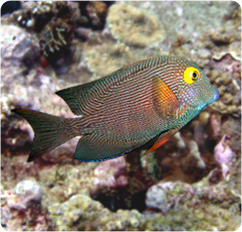|
Mark Martin on Clipless Seaweed Feeding
Mark Martin is Director of Marine Ornamental Research at Blue Zoo
 |
| Yellow Eye Kole Tang (Ctenochaetus strigosus) |
It is common for aquarist to use algae clips as a means to effectively feed Nori or commercially prepared seaweed strips to herbivorous fishes. The algae clip is usually affixed to the aquarium wall by way of a suction cup, and the seaweed is then attached to the clip. The result is a strip of seaweed that waves in the current and, usually, is devoured by herbivorous (and some omnivorous) fishes. I have no problem with feeding seaweed this way, as it is quick and easy and suits many fishes quite well. What I want to discuss in this week’s “Ask Mark” column, however, is a more natural method for feeding seaweed to herbivorous fishes , particularly species of algae-scraping fishes like the yellow eye kole tang (Ctenochaetus strigosus).
Algae scraping fishes, like some tangs and a few blennies, feed, at least in part, by “scraping” soft algae from hard substrate. Other herbivores (like many rabbitfishes) will happily tear through strands or leaves of macroalgae. While some of the scraping fishes may attempt to “rip and tear” seaweed delivered by way of an algae clip, it is far more natural and easier for them to eat seaweed presented in a manner closer to that which they find in the wild. I have personally been using the following technique for years in my own aquaria, and we now use it as our exclusive means of feeding scraping herbivorous fishes here at Blue Zoo Aquatics. One of the best parts about this method is that it is both simple and inexpensive.
Take a strip of seaweed (Nori or any commercially available, prepared seaweed strips) and soak the strip completely in RO (reverse osmosis) freshwater for about ten minutes or until it is sufficiently soft and slimy. Then take a four-inch section (the length doesn’t really matter, but four inches is convenient) of either one inch or one-and-one half PVC pipe and wrap the wet seaweed around the PVC. Secure the seaweed in place with a couple of rubber bands.
Place the seaweed wrapped PVC in the sun and allow it to dry for a day. As it dries, the seaweed will glue itself like cement to the PVC pipe. After that, simply removed the rubber bands and place the seaweed encrusted PVC in the aquarium. Herbivorous fishes will be attracted to the seaweed and will scrape the algae off the pipe as opposed to tearing it from an algae clip: a much more natural and enjoyable experience for some types of herbivores. Happy feeding!
If you have a question you would like answered in my weekly “Ask Mark” column, please e-mail me at mark@bluezooaquatics.com. To see all of the past “Ask Mark” tips, please visit the Blue Zoo Aquatics Resources page.
Published 18 August 2008. © Blue Zoo Aquatics
|